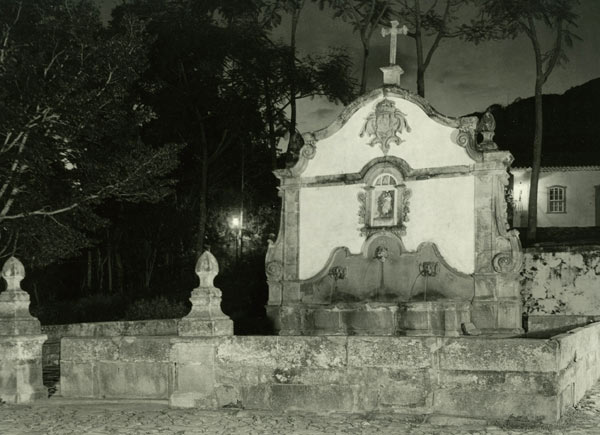
Everyone has seen a photographer, in movies, burning something that seems to make more smoke than light. That was the flash powder. It consists of a metal part and an oxidant. A mixture that resembles gunpowder. This was used for photography from its very first decades up to nearly mid of the twentieth century. Then fortunately it was replaced by cleaner, practical and safer means. However, the amount of light that these mixtures produce, is something that has not ceased to be interesting. Then, with planning, care and common sense, it is possible to experience the powder light in some situations. The fountain in the city of Tiradentes, in Minas Gerais – Brazil, pictured above, was completely in the dark, anything flammable nearby, empty streets made of stone … and only a coffee spoon did it all! It is not something to be ignored by a serious amateur photographer.
This post is in the “do it yourself” section. But still worth a historical introduction because those wanting to try the flash powder, they will have to improvise some apparatus to carry out its burning. In this sense, it is worth seeing what was used and the problems that had to be solved. It certainly will give inspiration for more interesting projects.
In former times
The flash powder, or lumière éclair in French, was probably brought to photography through the theater and scenographic arts, it was part of the special effects. It was adopted by professional photographers because the films were slow and in many situations they could not rely on natural light. But the flash powder really became popular with the introduction of cameras such as Kodak Brownie 2, 1901, for the general public, using films 120, with a claustrophobic opening of only f16. Professional photographers could afford to use lenses as Heliar or Euryscope, with openings reaching f4,5. But the overall weekend photographer needed more light, much more.
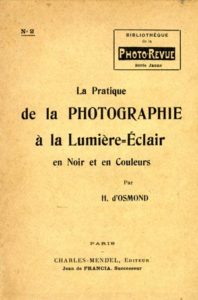 To their rescue came many companies manufacturing devices and mixes of flash powder. Kodak offered a multitude of options, including the Kodak Amateur Flash Outfit. Also books and magazines dedicated a good share of their articles to the topic of flash powder and its use. The cover on the left side is from a booklet that gives an overview of what was available in the early twentieth century. There is no publishing date, but by the type of equipment it features, must have been in the first quarter of the century.
To their rescue came many companies manufacturing devices and mixes of flash powder. Kodak offered a multitude of options, including the Kodak Amateur Flash Outfit. Also books and magazines dedicated a good share of their articles to the topic of flash powder and its use. The cover on the left side is from a booklet that gives an overview of what was available in the early twentieth century. There is no publishing date, but by the type of equipment it features, must have been in the first quarter of the century.
It classifies into three types the devices for flash powder use. A first group is made with those that use an alcohol flame produced by a lamp and pours or throws the dust over this flame. This immediately ignites and there is an effect, as with the gunpowder, wherein after a first spark the powder itself induces a immediate and complete burning of all. The difference in regards to the gunpowder is that in the case of flash powder the burning is considered slow and produces a lot of heat, lots of light, but there is no explosion.
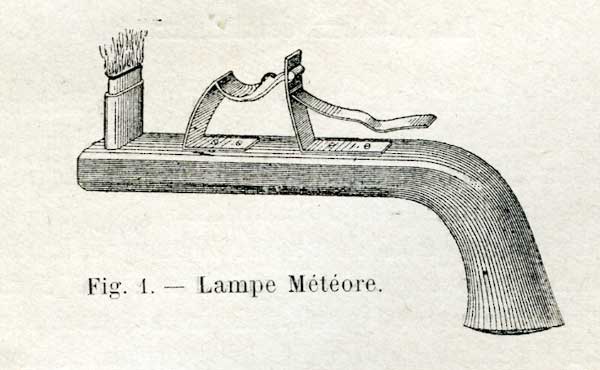
A model using this concept is the Lampe Météore. At the tip, on the left, there is a wick with alcohol, in the center a spring, on which flash powder is deposited, and on the right a trigger that releases the spring at the desired time. The gun format is suggestive and leaves no doubt: this flash is a weapon.

For the professional, a certain manufacturer Clifford, offered a Flash Light Machine, with no less than 18 alcohol lamps and a width of two meters. The powder was placed in a trough and timely were poured over the flames producing light that was for sure very strong as a large quantity of flash powder could be burnt in one stroke. It was also more diffuse, as there were 18 sources. The book’s author wisely argues that this system having flames and alcohol, so close to combustible powder, is not really the ideal setting in terms of safety.
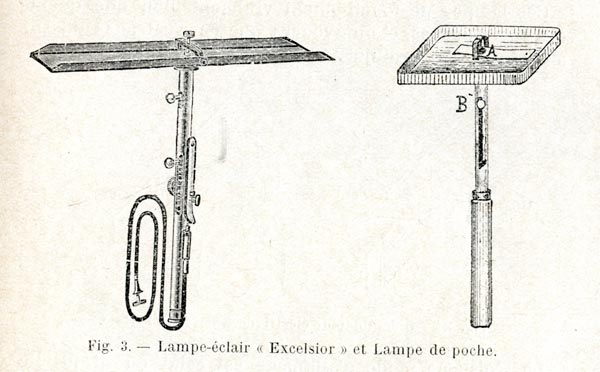
The second category of equipment for flash powder is the one in which the powder is deposited onto a sort of small gutter and ignition takes place from the center. The spark is produced by a single flame or by a mechanism that uses sparks from cerium-iron, which is flint. When rubbed it emits sparks that trigger the burning process. This is the case of models as Lampe-Éclair Excelcior and a generic Lampe de poche (pocket type), shown above. These are much safer options than pouring powder on a alcohol lighted lamp. But the author says that the use of flint was not very well settle as the heat from burning easily spoiled the trigger mechanism and the flint itself.
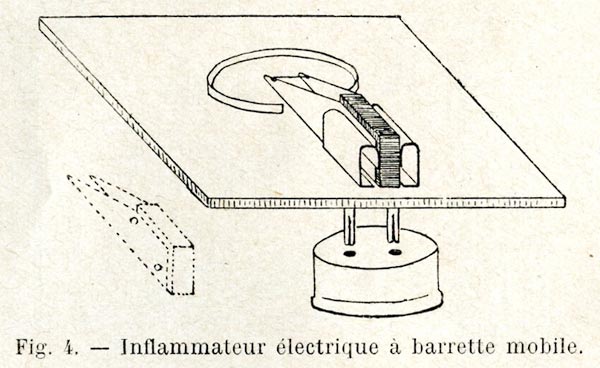
The third category is one that utilizes an electric fuse. An electrical current on a filament (the one that appears between the two metal tips in the center of the platform) becomes red-hot and this triggers the flash powder ignition. With that kind of device, timing also it is much better controlled and the exact moment of the flash becomes more predictable.
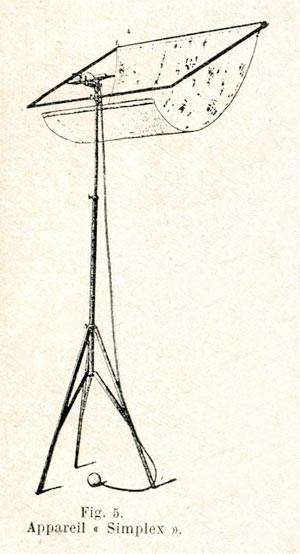 The flash powder light tends to be too harsh because the light source has small dimensions. Some creations were in the direction of introducing what we now call the hazy light. This is a diffuser that should receive much of the light that comes from the burning of powder and redistribute it onto the subject.
The flash powder light tends to be too harsh because the light source has small dimensions. Some creations were in the direction of introducing what we now call the hazy light. This is a diffuser that should receive much of the light that comes from the burning of powder and redistribute it onto the subject.
The Simplex, on the left, does exactly that. A tissue located just below the burner will work as a hazy light and illuminate what is below it. This gives important information on the way the powder burns, from both points of view: technical and safety. The light does not come exactly from where the powder is. It does not burn standing in the place where it was placed. That’s why it can be placed in a trough or container, some even a bit deep, because when burning it rises and forms like a cloud of light just above where it started burning. That means we must leave room also for a good meter or so above the burner. Ceiling, trees, pipes, electric wires, everything that is above the flash-powder unless it keeps a good distance, are likely to be burnt.
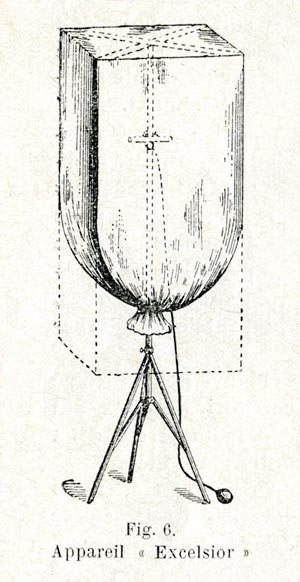 This alternative model of Excelsior solves two problems at once. Placed inside something like a balloon, the flash powder burner is confined between four walls. Two of them are reflective inside. The other two are light diffusers..
This alternative model of Excelsior solves two problems at once. Placed inside something like a balloon, the flash powder burner is confined between four walls. Two of them are reflective inside. The other two are light diffusers..
One advantage of this model is that it imprisons the smoke. Burning actually produces a lot of smoke. It may not be so noticed if you are outdoors, but I’ve done pictures with flash powder in my living room and I can say that the smoke comes in great quantity. At first, it spreads throughout the ceiling because it has such a high temperature. It is a nice first effect. But soon it cools down fall all over.
With the Simplex, the author of the booklet explains that after every click you can go out of the house and empty the smoke of the bag through the opening it has underneath. This gives an idea of how it is thick.
There is no information on the dimensions of Excelsior, but my little experience with flash powder tells me that it should be quite large. With a quantity of powder as a coffee spoon, burning can singe anything up to 30 cm away, and the heat released is huge, as it has been said. So, for safety reasons and avoiding to start a fire, it’s good to free at least a distance of about 60 cm in all directions from the point where the burning will occur. This is proportional to the amount of powder and, in any case, in domestic situations, it is better to stay with very low quantities.
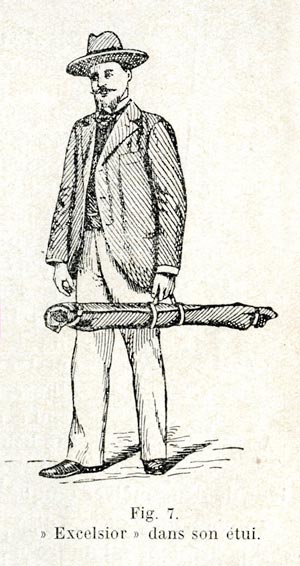 Photographic equipment manufacturers have always been concerned with easiness of use and also in communicating a certain lifestyle for photography enthusiasts. This illustration shows how conveniently one can take the Excelsior anywhere, thanks to its ingenious folding and case, without having its elegance compromised.
Photographic equipment manufacturers have always been concerned with easiness of use and also in communicating a certain lifestyle for photography enthusiasts. This illustration shows how conveniently one can take the Excelsior anywhere, thanks to its ingenious folding and case, without having its elegance compromised.
As for situations where the flash powder showed its advantages, bearing in mind its outlined inherent risks, especially we have the indoor scenes, night and even more in large ambiances such as theaters and halls. For photos of large groups and events whose date and time were already fixed beforehand, the photographer could not count on good weather and good natural lighting. Sometimes, even with this condition, it could happen that the camera’s position in relation to its subject would not be favorable and a fill in flash could be necessary.
It is difficult to speak in power with such rudimentary technology, but I’ve done photos with flash powder during sunny days and it is a fact that one can clearly notice that the magic coffee spoon gives a good softened on shadows to subjects around 4 meters away.
In that same booklet, La pratique de la photographie à lumière éclair, there is a picture that illustrates the use of flash powder. It’s really hard to imagine how, with slow films from the beginning of the century (equivalent to ASA en around 10 or 20), a picture of a theater stage like this could be done with other types of lighting.
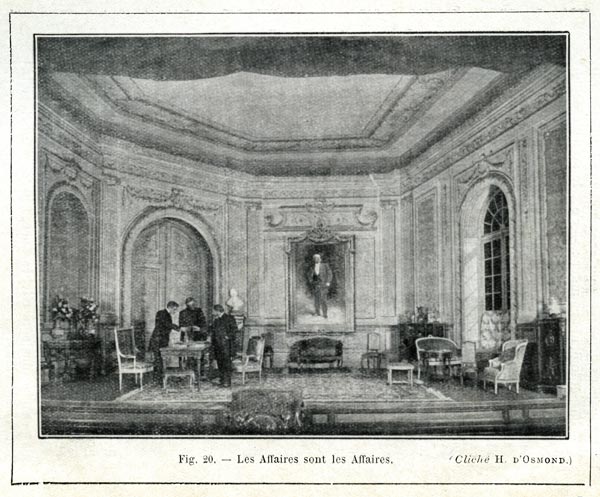
But as it has always been, the genre where most manufacturers put their bets, was the family portrait. Picture below is a page in a publication entitled Kodak: Comment obtenir Bonnes Photographies – Guide de l’Amateur Photographe (How to get good pictures – Amateur photographer guide). Unfortunately it has no publishing date, but again, by the mentioned equipments it is certainly from early twentieth century as well.
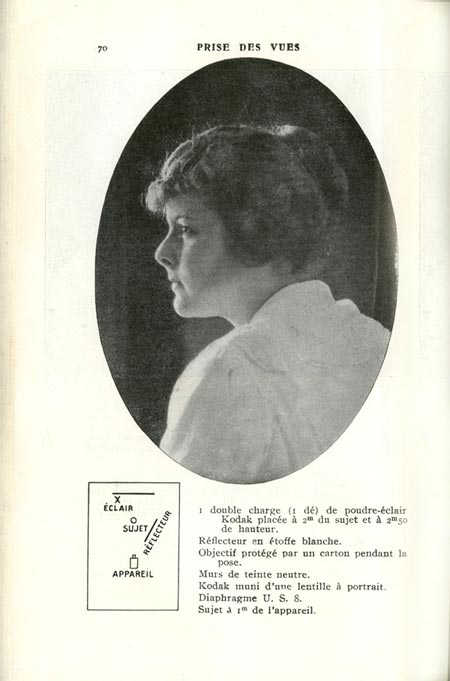
The text reads as follows: 1 double load (1 dice [one cube sized as a dice]) of flash powder Kodak set to 2 meters away from the portrayed and 2.5 m high. Reflector in white fabric. Objective protected by a card during the exposure [beyond being a good practice anyway, there was no lens coating yet, and then it became a mandatory practice]. Walls in a neutral color. With a Kodak portrait lens attachment. U.S. diaphragm 8. Camera 1m from subject.
The lens for portraits was an close-up lens needed because cameras, especially the box type, as the Brownies, had fixed focus at hyperfocal distance and not to one meter. U.S. diaphragm 8 is equivalent to f11,3 usual today’s f-numbers. Let’s consider for a while the situation of our former amateur photographer and ask ourselves: who using, maybe better to say suffering, with a film below ASA 20, with a f11 lens aperture, seeing a beautiful picture like the one above, would not haste and buy the so called poudre éclair? Yes, it made all the difference.
Preparing the flash powder
There are many recipes that are all variations on a basic idea of putting together a metal and an oxidant. The metal is used as a fuel, more than often aluminum or magnesium. The oxidant role is to provide oxygen at a rate that air alone could not. Once you have a spark triggered by a flame or electric discharge, there is a chain reaction and the metal is consumed in fractions of a second.
The most common formula used by amateur photographers consists of only two components: magnesium powder (Mg in periodic table) and Potassium Nitrate (KNO3). The method of preparation is simple, just dry mix the two in equal parts by weight.
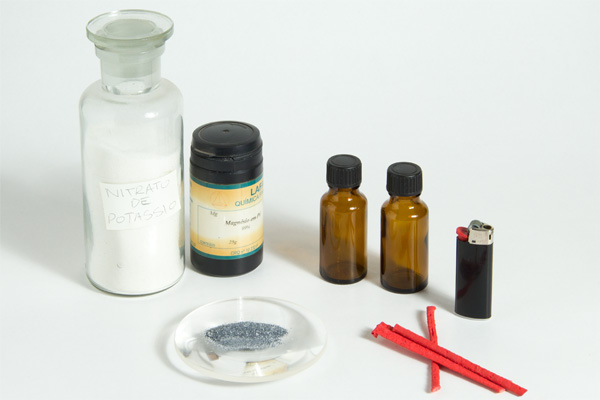
Magnesium is a gray powder such as iron powder and potassium nitrate is a white powder. The finer the better, especially Potassium Nitrate, ideally, should be fine as flour for the best performance. About supply, you need to find a dealer of chemical reagents. In some countries you need to register as these substances are controlled. Good thing is that they are sold in small quantities. This magnesium black bottle in the photo is only 25g. The ideal is not to stock a ready mix. Do it soon before use, same day or the day before, as the ready powder loses its features over time. I use two small amber vials and put a maximum of 1/3 of the volume of magnesium and potassium nitrate in each. Then I pour the contents of one into another and slowly turn it to mix evenly.
To light it up I use a slow fuse, they are the red stems that appear in the photo. There are two types: fast and slow fuse and are found in fireworks stores. The fast is instant, you turn on one side and it runs immediately to the other at a speed you can’t see it. As for the slow, the flame runs roughly 1 cm per second, but this should vary from manufacturer to manufacturer. I use a common cigarette lighter as a fuse igniter.
There are electric fuses but I never tried them. The slow burning fuse I use as follows: I light one that will last about 10 seconds to reach the other end where the flash powder is. This is the time for me to reach the cable release and to pay attention to fire at the right time. It seems difficult but it is workable. About timing check the post Agfa Flash Lampe, there are further considerations about timing.
You can also create other types of sync with the fast or electrical fuse. A fast fuse can be ignited electrically, and then light up the flash powder, in case the electric igniter is not sufficient to start the process with a mixture of potassium nitrate and magnesium. Although it is very flammable, I have noticed that it is not any spark that does the job.
A apparatus for flash powder
That will depend entirely on your attraction for bricolage and above all how much you intend your flash lampe to last. One metallic can, used for food, nailed in a wood stick may serve, but it will last maybe just once as it can melt with the heat of the first burning. I did a DIY project with things I had already in house. If you’re the type having difficulties to throw things away, like me, you may have everything you need as well.
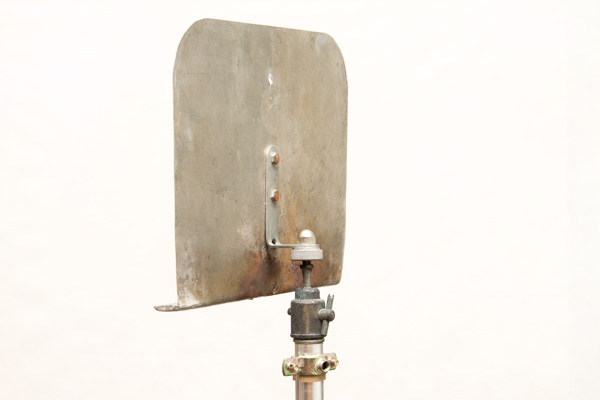
The above device consists of:
- A folded stainless steel sheet measuring 20x 25 cm and about 0.5 mm thick
- A L bracket
- A tripod camera adapter with large threads to small
- A nut
- An old small tripod head.
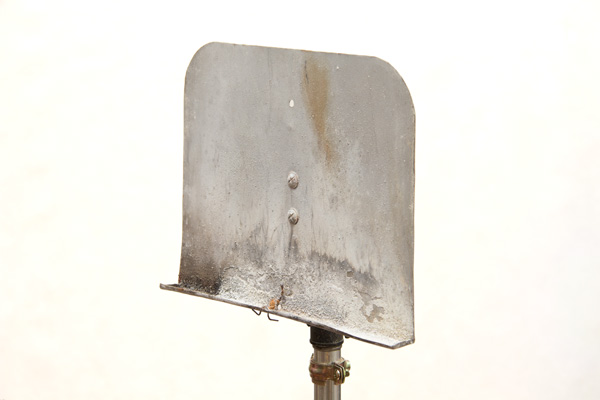
The front has a fold to put an amount of flash powder and a hole in the middle through which the fuse is inserted leaving a tip showing on the back.
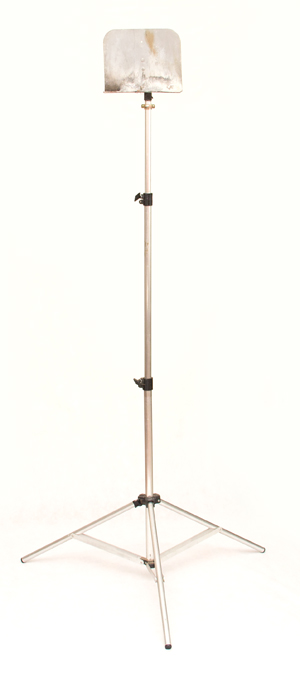
The good thing on this “model” is that it can be mounted on one of these photographic studio stands and it is very practical and safe. The good fixing apparatus for burning powder is a safety item that can not be overlooked. Always ask yourself: could it fall? What about wind? Are there children around? Can someone distracted bump on it?
But see how the burning goes consuming everything. The tripod head was brand new and nickel-plated, the steel sheet seemed indestructible. But all that comes into contact with sparks, even at some distance, is quite affected.
The high “wall” that rises behind the gutter is something that I thought would be good thing to create a more protected area behind, generally where the camera and photographer are, and as a light bouncer. I saw this concept and liked it in the pocket size Agfa I mentioned just above.
The fountain photo in Tiradentes was made with this stand using the slow fuse and no more than a coffee spoon of flash powder. Because it was dark, I did not worry too much about sync and took a longer shutter time to be sure it would cover it all. I used a Crow Graphic 23 with adapter for film 120. The opening was f11.
About exposure, “guide number”, distance or any other means to predict how much light will generate the flash powder burning, it is impossible to predict. The ideal is to experiment with a specific lamp and mixture. Then, for each set, one can expect a certain consistency while main variables are kept. I tried measuring light with my Sekonic flash meter but it did not work.
I believe that this is the kind of old technology that goes well with the new one, say the digital photography. Because it is very convenient when you can see the result in real time and adjust the lens aperture, shutter, distance, or whatever, and redo until you get the envisaged result.
One last word about safety. This is not something to do without a lot of preparation and providing for everything that can go wrong and taking in advanced measures to prevent them. It was something done routinely by amateurs in early twentieth century, can’t be that someone, 100 years later, will not be able to repeat it without accidents. Some basic rules:
- Never mix or carry large quantities. Prepare and take just enough. First, because you will not use it, second because it spoils over time and third because in the occurrence of an accident the greater the amount the greater the damage.
- Never mix with a stirrer, spoon, chopstick and nothing of the sort. Use a larger container and go spinning and moving so the powder mix loosely and without being pressured.
- Wear safety glasses.
- The greatest risk of accidents, as with fireworks, is probably in be the looseness of the piece that will sustain the powder flash for burning. Make sure that it is secure and free of instabilities. Consider if wind presents a danger. Keep the apparatus out the area of not concerned people.
- Do not leave anything you like less than 1 meter away.
- Burn a fuse alone to see how it goes, burn a bit of flash powder on the ground, on a stone, wood or brick. Test everything one step at a time before performing the full sequence.
Unlike fireworks flash powder does not produce an explosion and accordingly is less dangerous, but, again, there are very high temperatures, it is fast and leaves no time to reaction. There is a lot of heat that detaches from the burning mixture. But it is worthwhile to try it out if you like photography, very rewarding.
![]()
one click feed back:
was this article helpful? [ratings]
How DID they do it? For years I have wondered and serached the internet in vain. Now here is the answer. Thank you.
Meanwhile I invented my own solution. I used not magnesium, but Lycopodium powder, an even older theatric flash powder. As far as I know, it doesn’t burn well unless suspended in the air, so I made a blowpipe unto the handheld bracket. Immediately after I release the camera, I blow the tube with force so the spores rise up into the air. I too came up with the alcohol lamp to ignite it. Wooosh!!
Did you meter the Lycopodium flash in any way? I’m about to shoot with Lycopodium powder and need to balance the light generated from the powder with a strobe. I’m trying to find some light meter readings so that I have a sense of my settings before the shoot. Thanks!
Hello, this is the first time I hear about Lycopodium flash, looks interesting. I am sorry but I can’t help you about that.